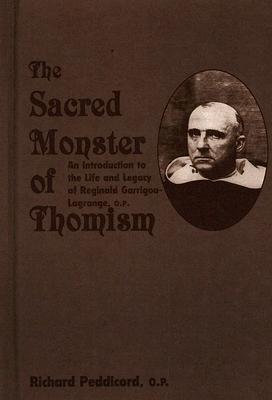The appellation “monstre sacré” for Reginald Garrigou-Lagrange, O.P. (1877-1964), was coined by François Mauriac, an influential Catholic litterateur and contemporary of Garrigou, suggesting the ill feelings harbored by those who found their theological or philosophical positions contradicted by Garrigou. In this book, Fr. Richard Peddicord, O.P., associate professor of systematic theology at the Aquinas Institute, St. Louis University, reintroduces us to the life and legacy of one of Catholicism’s most influential theologians in the period before Vatican II.
Garrigou was a Dominican and the leader of the neo-Thomist revival. His writings strongly influenced Catholic philosophy well beyond the middle of the 20th century. He was a great champion against modernism, described in Pius X’s encyclical Pascendi Dominici Gregis (1907) as the synthesis of all heresies. While difficult to summarize, modernism’s basic foundation is a denial of the possibility of knowing objective truth. It is grounded not in science, but in Kantian immanentism, which sees “reality” as a projection of internal needs and sentimentalism. Garrigou’s work fell into disfavor during the Second Vatican Council with the rise of historical Thomism, or la nouvelle théologie. Historical Thomism basically applied the historical-critical method of research, attempting to find the real Thomas Aquinas amidst the presumed accretions of interpretive contextualization. (We are more familiar with this methodology as used in “the search for the historical Jesus.” As if the Gospels portray a fictional one!)
The main proponent of la nouvelle théologie was M. Dominique Chenu, O.P. (1895-1990), who had been Garrigou’s prize student at the Angelicum. His work on Aquinas’s “evangelical humanism” was incorporated into such conciliar texts as Gaudium et Spes (1965). Garrigou roundly condemned Chenu’s methodology since, he believed, it contradicted the living Thomistic tradition as it had been passed on through Cajetan, Bañez, et al. Garrigou railed against Chenu and company, declaring that “uncovering a proposition’s historical pedigree does not provide one with data pertaining to its veracity.” Garrigou’s concern was for objective truth, which can only be grasped when mind conforms to reality. He held that theology is grounded in a set of divinely revealed truths that illumine human reason weakened by Original Sin. These truths do not change.
In light of the aftermath of Vatican II and the general confusion that ensued, Garrigou’s criticisms of la nouvelle théologie certainly carry more weight. Two examples come to mind. First, the traditional Catholic understanding of the social kingdom of Christ, which promoted a model of the ideal state as working in consort with the Church to help humans achieve their final good, God, was seemingly contradicted in Dignitatis Humanae (1965). This document, which encouraged a secular state permitting freedom of religion, was inspired by John Courtney Murray, S.J., an American proponent of la nouvelle théologie. (The theological argument is epitomized by Garrigou’s falling out with Jacques Maritain, who supported the secular Gaullist government of France over the Vichy regime of Marshal Pétain, which promoted religious education and subsidized private schools.) Second, the strong emphasis on humanistic principles in Gaudium et Spes caused many Baby Boomers to lose sight of man’s ultimate purpose, which is Heaven. (I remember vividly a prayer used at my college seminary, circa 1969, entitled “I believe in Man.”) This emphasis on secular humanism has had a devastating effect on Catholic spirituality.
The spiritual and concomitant moral decline in the West following the council no doubt moved Pope John Paul II to issue the encyclical Veritatis Splendor (1995), emphasizing moral absolutes. And, in 1998, he reiterated traditional Thomistic principles in Fides et Ratio (1998), which reaffirms the supernatural order, human reason’s capacity to know God, and our ability to arrive at the basic truths of existence, while once more confirming the necessity of divine revelation to open man to the truth. (The late Pope was both a former student of Garrigou and an attending bishop at Vatican II.) Both encyclicals may be seen as damage control in response to historical Thomism’s unfortunate influence on, and the interpretation given to, some of the council’s documents.
Peddicord provides the reader with a chronology of Garrigou’s major philosophical and theological battles, while presenting him as a deeply devoted son of Saint Dominic, and gives us a brief exposé of his important insights into ascetic theology. In so doing, Peddicord has succeeded in moving me to read Garrigou’s Three Ages of the Spiritual Life, a two-volume work that belongs in every Catholic library. Garrigou’s appreciation of the high calling of every Christian to contemplation, made possible through baptismal grace, is testimony to his respect for persons and tempers its author’s stern image with that of a more benign spiritual father. Peddicord’s work should resurrect the study of Garrigou-Lagrange—his polemic with the philosophical relativism of Blondel and Bergson, his vigilant battle against modernism, and his battles against la nouvelle théologie. His work especially deserves reassessment in light of contemporary secularism and Pope Benedict’s concern about “the dictatorship of relativism” now gripping Western civilization. Readers are likely to come away from this book with a desire to know more about a scholar who was loyal to the Church and Her embrace of traditional Thomism—one who, as we may now see, was more often right than wrong.
[The Sacred Monster of Thomism: An Introduction to the Life and Legacy of Reginald Garrigou-Lagrange, O.P., by R. Peddicord, O.P. (South Bend, IN: St. Augustine’s Press) 232 pp., $25.00]

Leave a Reply